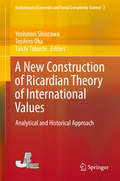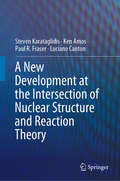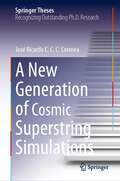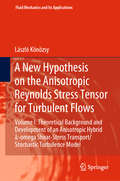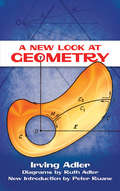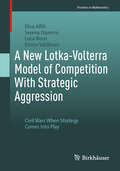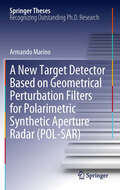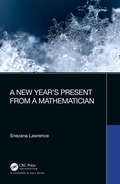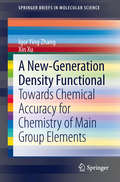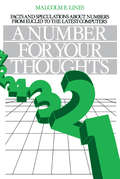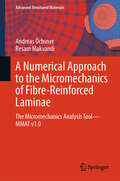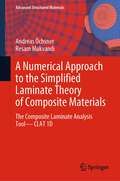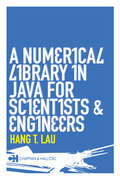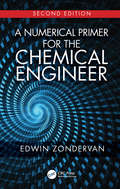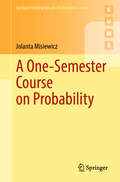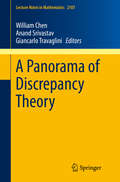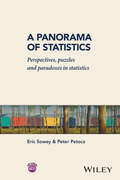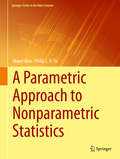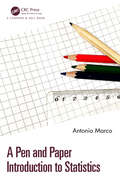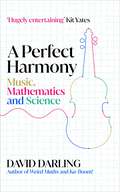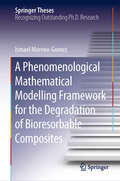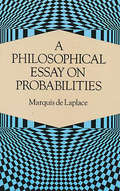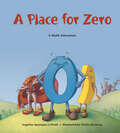- Table View
- List View
A New Construction of Ricardian Theory of International Values: Analytical and Historical Approach (Evolutionary Economics and Social Complexity Science #7)
by Yoshinori Shiozawa Tosihiro Oka Taichi TabuchiThis is the first book published in English on the new international value theory, presented by Yoshinori Shiozawa in 2007. Shiozawa submitted a solution to the question on international values since Ricardo by constructing a Ricardo-Sraffa model on trading economies with M countries and N commodities including intermediate inputs (normally M
A New Development at the Intersection of Nuclear Structure and Reaction Theory
by Steven Karataglidis Ken Amos Paul R. Fraser Luciano CantonThis book highlights a major advance in low-energy scattering theory: the Multi-Channel Algebraic Scattering (MCAS) theory, which represents an attempt to unify structure and reaction theory. It solves the Lippmann–Schwinger equations for low-energy nucleon-nucleus and alpha-nucleus scattering in momentum space, allowing both the bound and scattering states in the compound nucleus formed to be described. Results of various cases are presented and discussed.
A New Generation of Cosmic Superstring Simulations (Springer Theses)
by José Ricardo CorreiraTopological defects are an expected consequence of phase transitions in the early Universe. As such these objects, if detected, provide unequivocal evidence of physics beyond the Standard Model. This means they are prime targets for new observational facilities. However, our understanding of defects is heavily bottlenecked by computational limitations. In this book, the author explores the use of accelerator hardware to alleviate this problem, presenting the world’s first (multiple-)GPU defect simulations. Such simulations can evolve a network of line-like cosmic strings at an unprecedented resolution. Then these are used to obtain the most accurate to date calibrations of semi-analytical modelling and to show the impact of accuracy on observational consequences of strings. Lastly, a modified version of this application is used to study interconnected networks of strings in greater detail than ever before. This book benefits any student or researcher who wishes to learn about field theory simulations in the early Universe and about supercomputing with multiple accelerators.
A New Hypothesis on the Anisotropic Reynolds Stress Tensor for Turbulent Flows: Volume I: Theoretical Background and Development of an Anisotropic Hybrid k-omega Shear-Stress Transport/Stochastic Turbulence Model (Fluid Mechanics and Its Applications #120)
by László KönözsyThis book gives a mathematical insight--including intermediate derivation steps--into engineering physics and turbulence modeling related to an anisotropic modification to the Boussinesq hypothesis (deformation theory) coupled with the similarity theory of velocity fluctuations. Through mathematical derivations and their explanations, the reader will be able to understand new theoretical concepts quickly, including how to put a new hypothesis on the anisotropic Reynolds stress tensor into engineering practice. The anisotropic modification to the eddy viscosity hypothesis is in the center of research interest, however, the unification of the deformation theory and the anisotropic similarity theory of turbulent velocity fluctuations is still missing from the literature. This book brings a mathematically challenging subject closer to graduate students and researchers who are developing the next generation of anisotropic turbulence models. Indispensable for graduate students, researchers and scientists in fluid mechanics and mechanical engineering.
A New Look at Geometry (Dover Books on Mathematics)
by Ruth Adler Irving Adler Peter RuaneThis richly detailed overview surveys the development and evolution of geometrical ideas and concepts from ancient times to the present. In addition to the relationship between physical and mathematical spaces, it examines the interactions of geometry, algebra, and calculus. The text proves many significant theorems and employs several important techniques. Chapters on non-Euclidean geometry and projective geometry form brief, self-contained treatments.More than 100 exercises with answers and 200 diagrams illuminate the text. Teachers, students (particularly those majoring in mathematics education), and mathematically minded readers will appreciate this outstanding exploration of the role of geometry in the development of Western scientific thought.Introduction to the Dover edition by Peter Ruane.
A New Lotka-Volterra Model of Competition With Strategic Aggression: Civil Wars When Strategy Comes Into Play (Frontiers in Mathematics)
by Luca Rossi Enrico Valdinoci Serena Dipierro Elisa AffiliThis monograph introduces a new mathematical model in population dynamics that describes two species sharing the same environmental resources in a situation of open hostility. Its main feature is the expansion of the family of Lotka-Volterra systems by introducing a new term that defines aggression. Because the model is flexible, it can be applied to various scenarios in the context of human populations, such as strategy games, competition in the marketplace, and civil wars. Drawing from a variety of methodologies within dynamical systems, ODEs, and mathematical biology, the authors' approach focuses on the dynamical properties of the system. This is accomplished by detecting and describing all possible equilibria, and analyzing the strategies that may lead to the victory of the aggressive population. Techniques typical of two-dimensional dynamical systems are used, such as asymptotic behaviors regulated by the Poincaré–Bendixson Theorem. A New Lotka-Volterra Model of Competition With Strategic Aggression will appeal to researchers and students studying population dynamics and dynamical systems, particularly those interested in the cross section between mathematics and ecology.
A New Target Detector Based on Geometrical Perturbation Filters for Polarimetric Synthetic Aperture Radar (Springer Theses)
by Armando MarinoThis thesis presents a groundbraking methodology for the radar international community. The detection approach introduced, namely perturbation analysis, is completey novel showing a remarkable capability of thinking outside the box. Perturbation analysis is able to push forward the performance limits of current algorithms, allowing the detection of targets smaller than the resolution cell and highly embedded in clutter. The methodology itself is extraordinary flexibe and has already been used in two other large projects, funded by the ESA (European Space Agency): M-POL for maritime surveillance, and DRAGON-2 for land classification with particular attention to forests. This book is a perfectly organised piece of work where every detail and perspective is taken into account in order to provide a comprehensive vision of the problems and solutions.
A New Year’s Present From a Mathematician
by Snezana LawrenceA New Year’s Present from a Mathematician is an exciting book dedicated to two questions: What is it that mathematicians do? And who gets to be called a ‘mathematician’ and why? This book seeks to answer these questions through a series of stories ranging from the beginning of modern mathematics through to the 20th century, but not in a usual, chronological manner. The author weaves her story around major questions concerning nature of mathematics, and links mathematicians by the substance of their ideas and the historical and personal context in which they were developed. Ideal as a gift for anyone with an interest in mathematics, this book gives a powerful insight into mathematical concepts in an easy-to-read-and-digest manner, without trivializing their nature. The attention given to engaging examples, framed within a poetic narrative structure, means that this book can be enjoyed by almost anyone, regardless of their level of mathematical education.
A New-Generation Density Functional: Towards Chemical Accuracy for Chemistry of Main Group Elements (SpringerBriefs in Molecular Science)
by Igor Ying Zhang Xin XuA New-Generation Density Functional: Towards Chemical Accuracy for Chemistry of Main Group Elements covers the most recent progress in the development of a new generation of density functional theory (DFT) for accurate descriptions of thermochemistry, thermochemical kinetics, and nonbonded interactions of main group molecules. In this book, the authors present the doubly hybrid density functionals (DHDFs), which dramatically improve the accuracy for predictions of critical properties by including the role of the virtual (unoccupied) orbitals. The authors not only discuss the theoretical bases of three classes of DHDFs but also demonstrate their performance using some well-established benchmarking data sets.
A Number for your Thoughts: Facts and Speculations About Numbers from Euclid to the Latest Computers
by M. E. LinesWhy do we count the way we do? What is a prime number or a friendly, perfect, or weird one? How many are there and who has found the largest yet known? What is the Baffling Law of Benford and can you really believe it? Do most numbers you meet in every day life really begin with a 1, 2, or 3? What is so special about 6174? Can cubes, as well as squares, be magic? What secrets lie hidden in decimals? How do we count the infinite, and is one infinity really larger than another? These and many other fascinating questions about the familiar 1, 2, and 3 are collected in this adventure into the world of numbers. Both entertaining and informative, A Number for Your Thoughts: Facts and Speculations about Numbers from Euclid to the Latest Computers contains a collection of the most interesting facts and speculations about numbers from the time of Euclid to the most recent computer research. Requiring little or no prior knowledge of mathematics, the book takes the reader from the origins of counting to number problems that have baffled the world's greatest experts for centuries, and from the simplest notions of elementary number properties all the way to counting the infinite.
A Numerical Approach to the Micromechanics of Fibre-Reinforced Laminae: The Micromechanics Analysis Tool—MMAT v1.0 (Advanced Structured Materials #218)
by Andreas Öchsner Resam MakvandiThis book treats the micromechanics of laminae, i.e., the prediction of the macroscopic mechanical lamina properties based on the mechanical properties of the constituents, i.e., fibers and matrix. The focus is on unidirectional lamina which can be described based on orthotropic constitutive equations. In detail, predictions for the modulus of elasticity in and transverse to the fiber direction, the major Poisson’s ratio, as wells as the in-plane shear modulus are provided. The mechanics of materials approach, the elasticity solutions with contiguity after Tsai, and the Halpin-Tsai relationships, are presented in detail. Composite materials, especially fiber-reinforced composites, are gaining increasing importance since they can overcome the limits of many structures based on classical engineering materials. Particularly the combination of a matrix with fibers provides far better properties than the single constituents alone. A typical basic layer, the so-called lamina, can be composed of unidirectional fibers which are embedded in a matrix. In a second step, layers of laminae may be stacked under different fiber angles to a so-called laminate, which reveals—depending on the stacking sequence—different types of anisotropy/isotropy. A Python-based computational tool is provided, the so-called Micromechanics Analysis Tool (MMAT v1.0) to easily predict the elastic properties. The tool runs in any standard web browser and offers a user-friendly interface with many graphical representations of the elastic properties as a function of the fiber volume fraction.
A Numerical Approach to the Simplified Laminate Theory of Composite Materials: The Composite Laminate Analysis Tool—CLAT 1D (Advanced Structured Materials #202)
by Andreas Öchsner Resam MakvandiA typical approach to treat composite materials, which are composed of layered unidirectional lamina, is the so-called classical laminate theory (CLT). This theory is based on the theory for plane elasticity elements and classical (shear-rigid) plate elements under the assumption of orthotropic constitutive equations. The solution of the fundamental equations of the classical laminate theory is connected with extensive matrix operations and many problems require in addition iteration loops.This two-dimensional approach and the underlying advanced continuum mechanical modeling might be very challenging for some students, particularly at universities of applied sciences. Thus, a reduced approach, the so-called simplified classical laminate theory (SCLT), has been recently proposed. The idea was to use solely isotropic one-dimensional elements, i.e., a superposition of bar and beam elements, to introduce the major calculation steps of the classical laminate theory. Understanding this simplified theory is much easier and the final step it to highlight the differences when moving to the general two-dimensional case.This monograph first provides a systematic and thorough introduction to the simplified laminate theory based on the theory for bars and classical beam plate elements. The focus is on stacking of isotropic layers to simplified laminates. In addition to the elastic behavior, failure is investigated based on the maximum stress, maximum strain, Tsai-Hill, and the Tsai-Wu criteria. We provide a Python-based computational tool, the so-called Composite Laminate Analysis Tool (CLAT 1D) to easily solve some standard questions from the context of fiber reinforced composites. The tool runs in any standard web browser and offers a user-friendly interface with many post-processing options. The functionality comprises stress and strain analysis of simplified lamina and laminates and the failure analysis based on different criteria.
A Numerical Library in Java for Scientists and Engineers
by Hang T. LauAt last researchers have an inexpensive library of Java-based numeric procedures for use in scientific computation. The first and only book of its kind, A Numeric Library in Java for Scientists and Engineers is a translation into Java of the library NUMAL (NUMerical procedures in ALgol 60). This groundbreaking text presents procedural descr
A Numerical Primer for the Chemical Engineer, Second Edition
by Edwin ZondervanDesigned as an introduction to numerical methods for students, this book combines mathematical correctness with numerical performance, and concentrates on numerical methods and problem solving. It applies actual numerical solution strategies to formulated process models to help identify and solve chemical engineering problems. Second edition comes with additional chapter on numerical integration and section on boundary value problems in the relevant chapter. Additional material on general modelling principles, mass/energy balances and separate section on DAE’s is also included. Case study section has been extended with additional examples.
A One-Semester Course on Probability (Springer Undergraduate Mathematics Series)
by Jolanta MisiewiczThis concise textbook covers the full scope of an introductory course in modern probability theory, from elementary combinatorial methods to the central limit theorem, while maintaining mathematical rigor. It includes key topics like the measure extension and the Radon-Nikodym theorems. Designed for a one-semester course, it is well-suited for theoretical mathematics, financial mathematics, insurance, or stochastic modeling students. With 375 exercises, it offers ample opportunities for study and review.
A Panorama of Discrepancy Theory (Lecture Notes in Mathematics #2107)
by Giancarlo Travaglini William Chen Anand SrivastavThis is the first work on Discrepancy Theory to show the present variety of points of view and applications covering the areas Classical and Geometric Discrepancy Theory, Combinatorial Discrepancy Theory and Applications and Constructions. It consists of several chapters, written by experts in their respective fields and focusing on the different aspects of the theory. Discrepancy theory concerns the problem of replacing a continuous object with a discrete sampling and is currently located at the crossroads of number theory, combinatorics, Fourier analysis, algorithms and complexity, probability theory and numerical analysis. This book presents an invitation to researchers and students to explore the different methods and is meant to motivate interdisciplinary research.
A Panorama of Statistics: Perspectives, Puzzles and Paradoxes in Statistics
by Peter Petocz Eric SoweyThis book is a stimulating panoramic tour – quite different from a textbook journey – of the world of statistics in both its theory and practice, for teachers, students and practitioners.At each stop on the tour, the authors investigate unusual and quirky aspects of statistics, highlighting historical, biographical and philosophical dimensions of this field of knowledge. Each chapter opens with perspectives on its theme, often from several points of view. Five original and thought-provoking questions follow. These aim at widening readers’ knowledge and deepening their insight. Scattered among the questions are entertaining puzzles to solve and tantalising paradoxes to explain. Readers can compare their own statistical discoveries with the authors’ detailed answers to all the questions. The writing is lively and inviting, the ideas are rewarding, and the material is extensively cross-referenced. A Panorama of Statistics: Leads readers to discover the fascinations of statistics. Is an enjoyable companion to an undergraduate statistics textbook. Is an enriching source of knowledge for statistics teachers and practitioners. Is unique among statistics books today for its memorable content and engaging style. Lending itself equally to reading through and to dipping into, A Panorama of Statistics will surprise teachers, students and practitioners by the variety of ways in which statistics can capture and hold their interest.Reviews:"As befits the authors' statement that 'this is not a textbook', the structure is unusual. There are twenty-five chapters organised in five sections, each beginning with a brief perspective of a theme in statistics and finishing with five questions related to that theme. The answers provided to the questions, in section six, are as discursive and illuminating as the main body of the text. Even if you are pretty sure you know the answer, it is always worth checking what the authors have to say. Chances are that you will learn something every time. The glimpses and insights given into this enormous and far-reaching discipline succeed in being bewitching, entertaining and inviting; coverage was never the aim." "In summary, this splendid book lives up to the four 'p-values' of its title. It is panoramic in the scope of its survey of statistics, it is full of illuminating perspectives, it sets entertaining and challenging puzzles, and it explores fascinating paradoxes. Read it, enjoy it and learn from it."From Neil Sheldon, Teaching Statistics, volume 9, no. 2, May 2017
A Parametric Approach to Nonparametric Statistics (Springer Series in the Data Sciences)
by Mayer Alvo Philip L. H. YuThis book demonstrates that nonparametric statistics can be taught from a parametric point of view. As a result, one can exploit various parametric tools such as the use of the likelihood function, penalized likelihood and score functions to not only derive well-known tests but to also go beyond and make use of Bayesian methods to analyze ranking data. The book bridges the gap between parametric and nonparametric statistics and presents the best practices of the former while enjoying the robustness properties of the latter. This book can be used in a graduate course in nonparametrics, with parts being accessible to senior undergraduates. In addition, the book will be of wide interest to statisticians and researchers in applied fields.
A Peck of Peaches: A Georgia Number Book
by Carol CraneUsing numbers to introduce topics, many of Georgia's famous people, landmarks, and state symbols are introduced including Martin Luther King Jr., the nine Great Lakes of Georgia, loggerhead sea turtles, and sharks' teeth.
A Pen and Paper Introduction to Statistics
by Antonio MarcoStatistics is central in the biosciences, social sciences and other disciplines, yet many students often struggle to learn how to perform statistical tests, and to understand how and why statistical tests work. Although there are many approaches to teaching statistics, a common framework exists between them: starting with probability and distributions, then sampling from distribution and descriptive statistics and later introducing both simple and complex statistical tests, typically ending with regression analysis (linear models). This book proposes to reverse the way statistics is taught, by starting with the introduction of linear models. Today, many statisticians know that the one unifying principle of statistical tests is that most of them are instances of linear models. This teaching method has two advantages: all statistical tests in a course can be presented under the same unifying framework, simplifying things; second, linear models can be expressed as lines over squared paper, replacing any equation with a drawing. This book explains how and why statistics works without using a single equation, just lines and squares over grid paper. The reader will have the opportunity to work through the examples and compute sums of squares by just drawing and counting, and finally evaluating whether observed differences are statistically significant by using the tables provided. Intended for students, scientists and those with little prior knowledge of statistics, this book is for all with simple and clear examples, computations and drawings helping the reader to not only do statistical tests but also understand statistics.
A Perfect Harmony: Music, Mathematics and Science
by David DarlingFrom the earliest of civilisations, humans have found ways to make music, whether through makeshift drums or artfully drilled bone flutes. But how did music – effectively little more than a series of certain tones and rhythms – become so integral to the human experience? Untangling the curious links between notes and number, musical perception, psychology and physics, David Darling examines the fascinating science behind music, from its Palaeolithic origins to the present. Revealing surprising connections and busting pervasive myths, A Perfect Harmony asks: Why do musicians tend to be better at maths than non-musicians? Why do we find some pieces sad and others happy? Will playing Mozart to babies predispose them to genius? Could an AI write the perfect symphony?
A Phenomenological Mathematical Modelling Framework for the Degradation of Bioresorbable Composites (Springer Theses)
by Ismael Moreno-GomezThis book presents a generalised computational model for the degradation of resorbable composites, using analytic expressions to represent the interwoven phenomena present during degradation. It then combines this modelling framework with a comprehensive database of quantitative degradation data mined from existing literature and from novel experiments, to provide new insights into the interrelated factors controlling degradation. Resorbable composites made of biodegradable polyesters and calcium-based ceramics have significant therapeutic potential as tissue engineering scaffolds, as temporary implants and as drug-loaded matrices for controlled release. However, their degradation is complex and the rate of resorption depends on multiple connected factors such as the shape and size of the device, polymer chemistry and molecular weight, particle phase, size, volume fraction, distribution and pH-dependent dissolution properties. Understanding and ultimately predicting the degradation of resorbable composites is of central importance if we are to fully unlock the promise of these materials.
A Philosophical Essay on Probabilities
by Marquis De LaplaceThis classic introduces the concepts and uses of probability theory. It demonstrates, without the use of higher mathematics, the application of probability to games of chance, physics, reliability of witnesses, astronomy, insurance, democratic government, and many other areas. It also shows how scientists can express complex ideas in simple terms.
A Philosophical Guide to Chance
by Toby HandfieldIt is a commonplace that scientific inquiry makes extensive use of probabilities, many of which seem to be objective chances, describing features of reality that are independent of our minds. Such chances appear to have a number of paradoxical or puzzling features: they appear to be mind-independent facts, but they are intimately connected with rational psychology; they display a temporal asymmetry, but they are supposed to be grounded in physical laws that are time-symmetric; and chances are used to explain and predict frequencies of events, although they cannot be reduced to those frequencies. This book offers an accessible and non-technical introduction to these and other puzzles. Toby Handfield engages with traditional metaphysics and philosophy of science, drawing upon recent work in the foundations of quantum mechanics and thermodynamics to provide a novel account of objective probability that is empirically informed without requiring specialist scientific knowledge.
A Place for Zero (Charlesbridge Math Adventures)
by Angeline Sparagna LoPrestiJoin Zero on his math adventure as he discovers his place through multiplication. Zero is lonely in Digitaria. He can't play Addemup with the other numbers because he has nothing to add. All the other numbers seem to belong and they all have a place, but when zero discovers multiplication he thinks he might have a place there. He sets out to find King Multiplus who also is curious about what will happen when Zero gets thrown in the mix. With math and wordplay A Place for Zero is the perfect introduction to multiplication and number placement. A playful way to make math less intimidating and more fun to explore.
